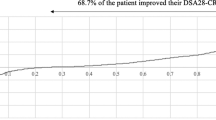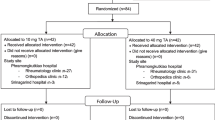Abstract
Intra-articular glucocorticoid (GC) injection has been used for more than half a century in the treatment of refractory synovitis in patients with rheumatoid arthritis (RA). There are limited data about the efficacy of intra-articular injection of various preparations of GCs on inflamed joint. The aim of this study was to compare the efficacy and side effects of intra-articular injection of dexamethasone (DEX) and triamcinolone hexacetonide (TH) in the treatment of knee joint arthritis in RA. In a double-blind randomized clinical trial, 70 patients with RA and knee joint arthritis were recruited to the study. Swelled knee joints were injected with 40 mg TH or 8 mg DEX randomly. The primary outcome measures were reduction of knee joint swelling and pain 1 and 3 weeks after joint injection. The secondary outcome measures were relapse of knee arthritis at 2, 4, and 6 months after injection and side effects of intra-articular injection. Difference in the knee circumferences between DEX and TH groups at weeks 1 and 3 was not significant. The average times of pain reduction after injection were 3.4 ± 2.3 and 2.3 ± 1.8 days in TH and DEX, respectively. There were no differences of knee pain between the two groups. Relapse of knee arthritis was occurred in two (6.7 %) and three (9.4 %) patients in the DEX and TH groups, respectively. Intra-articular injection of DEX like TH causes rapid and long-term reduction of knee pain and swelling in patients with RA and is safe.




Similar content being viewed by others
References
Davatchi F, Jamshidi AR, Banihashemi AT, et al. (2008) WHO-ILAR COPCORD study (stage 1, urban study) in Iran. J Rheumatol 35(7):1384
Peschken CA, Esdaile JM (1999) Rheumatic diseases in North America's indigenous peoples. Semin Arthritis Rheum 28(6):368–391
Taylor WJ, Fransen J, Dalbeth N, et al. (2016) Diagnostic arthrocentesis for suspicion of gout is safe and well tolerated. J Rheumatol 43(1):150–153
Jacobs JW (2009) How to perform local soft-tissue glucocorticoid injections. Best Pract Res Clin Rheumatol 23(2):193–219
Cheng OT, Souzdalnitski D, Vrooman B, Cheng J (2012) Evidence based knee injections for the management of arthritis. Pain Med 13(6):740–753
Dent PB, Walker N (1998) Intra-articular corticosteroids in the treatment of juvenile rheumatoid arthritis. Curr Opin Rheumatol 10(5):475–480
Sherry DD, Stein LD, Reed AM, Schanberg LE, Kredich DW (1999) Prevention of leg length discrepancy in young children with pauciarticular juvenile rheumatoid arthritis by treatment with intraarticular steroids. Arthritis Rheum 42(11):2330–2334
Caldwell JR (1996) Intra-articular corticosteroids. Guide to selection and indications for use. Drugs 52(4):507–514
Lo YJ, Sheu MT, Tsai WC, et al. (2007) Intra-articular injection of hyaluronate and indomethacin in rabbits with antigen-induced arthritis. Rheumatol Int 27(12):1099–1111
Makrygiannakis D, Klint E a, Catrina S-B, Botusan IR (2006) Intraarticular corticosteroids decrease synovial RANKL expression in inflammatory arthritis. Arthritis Rheum 54(5):1463–1472
Makrygiannakis D, Revu S, Engström M, et al. (2012) Local administration of glucocorticoids decreases synovial citrullination in rheumatoid arthritis. Arthritis Res Ther 14(1):R20
Wei AS, Callaci JJ, Juknelis D, et al. (2006) The effect of corticosteroid on collagen expression in injured rotator cuff tendon. J Bone Joint Surg Am 88(6):1331–1338
Huscher D, Thiele K, Gromnica-Ihle E, et al. (2009) Dose-related patterns of glucocorticoid-induced side effects. Ann Rheum Dis 68(7):1119–1124
Weitoft T, Rönnelid J, Knight A, Lysholm J, Saxne T, Larsson A (2014) Outcome predictors of intra-articular glucocorticoid treatment for knee synovitis in patients with rheumatoid arthritis-a prospective cohort study. Arthritis Res Ther 16(3):R129
Jahangier ZN, Jacobs JWG, et al. (2011) Can simple ultrasonography predict the clinical effect of intra-articular injection therapy of the knee joint? Clin Rheumatol 30(6):749–755
Dernis E, Ruyssen-Witrand A, Mouterde G, et al. (2010) Use of glucocorticoids in rheumatoid arthritis—pratical modalities of glucocorticoid therapy: recommendations for clinical practice based on data from the literature and expert opinion. Joint Bone Spine 77(5):451–457
Sinha A, Bagga A (2008) Pulse steroid therapy. Indian J Pediatr 19(85):420–423
Sadra V, Khabbazi A, Kolahi S, Hajialiloo M, Ghojazadeh M (2014) Randomized double-blind study of the effect of dexamethasone and methylprednisolone pulse in the control of rheumatoid arthritis flare-up: a preliminary study. Int J Rheum Dis 17(4):389–393
Lapin L (1961) Experiences with intra-articular dexamethasone TBA. Can Med Assoc J 19(85):420–423
Aletaha D, Neogi T, Silman AJ, et al. (2010) Rheumatoid arthritis classification criteria. Arthritis Rheum 62(9):2569–2581
Padeh S, Passwell JH (1998) Intraarticular corticosteroid injection in the management of children with chronic arthritis. Arthritis Rheum 41(7):1210–1214
Breit W, Frosch M, Meyer U, Heinecke A, Ganser G (2000) A subgroup-specific evaluation of the efficacy of intraarticular triamcinolone hexacetonide in juvenile chronic arthritis. J Rheumatol 27(11):2696–2702
Jahangier ZN, Jacobs JW, Lafeber FP (2005) Is radiation synovectomy for arthritis of the knee more effective than intraarticular treatment with glucocorticoids? Arthritis Rheum 52(11):3391–3402
Eberhard BA, Sison MC, Gottlieb BS, Ilowite NT (2004) Comparison of the intraarticular effectiveness of triamcinolone hexacetonide and triamcinolone acetonide in treatment of juvenile rheumatoid arthritis. J Rheumatol 31(12):2507–2512
Zulian F, Martini G, Gobber D, Plebani M, Zacchello F, Manners P (2004) Triamcinolone acetonide and hexacetonide intra-articular treatment of symmetrical joints in juvenile idiopathic arthritis: a double-blind trial. Rheumatology (Oxford) 43(10):1288–1291
Blyth T, Hunter JA, Stirling A (1994) Pain relief in the rheumatoid knee after steroid injection. A single-blind comparison of hydrocortisone succinate, and triamcinolone acetonide or hexacetonide. Br J Rheumatol 33(5):461–463
Bird HA, Ring EF, Bacon PA (1979) A thermographic and clinical comparison of three intra-articular steroid preparations in rheumatoid arthritis. Ann Rheum Dis 38(1):36–39
Garg N, Perry L, Deodhar A (2014) Intra-articular and soft tissue injections, a systematic review of relative efficacy of various corticosteroids. Clin Rheumatol 33(12):1695–1706
Acknowledgments
This study was supported by the research funds of Tabriz University of Medical Sciences. The authors extend their gratitude to Dr. L. Khabbazi for editing this manuscript.
Author information
Authors and Affiliations
Corresponding author
Ethics declarations
All of the authors declare that this study was performed in accordance with the ethical standards laid down in the 1964 Declaration of Helsinki and its later amendments. All persons gave informed consent prior to participation in this study.
Disclosures
None.
Financial disclosure
No financial interests related to the material in the manuscript.
Funding support
None declared.
Rights and permissions
About this article
Cite this article
Hajialilo, M., Ghorbanihaghjo, A., Valaee, L. et al. A double-blind randomized comparative study of triamcinolone hexacetonide and dexamethasone intra-articular injection for the treatment of knee joint arthritis in rheumatoid arthritis. Clin Rheumatol 35, 2887–2891 (2016). https://doi.org/10.1007/s10067-016-3397-4
Received:
Revised:
Accepted:
Published:
Issue Date:
DOI: https://doi.org/10.1007/s10067-016-3397-4




